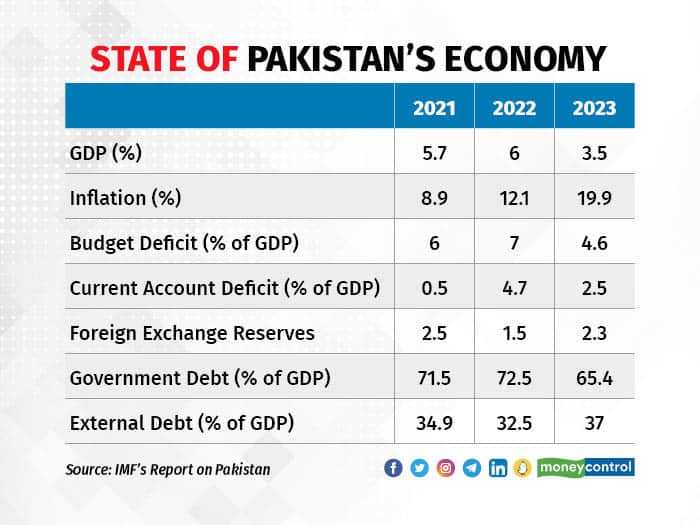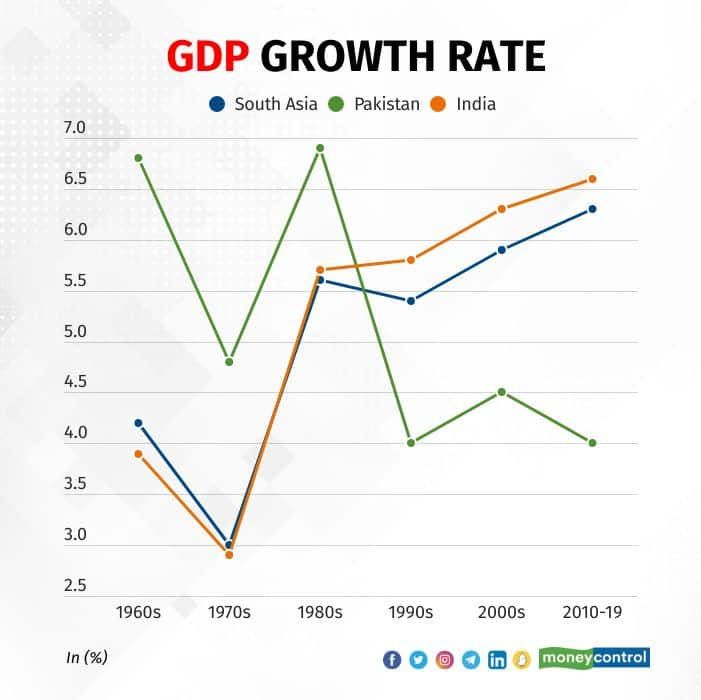



Pakistan is beset by a serious economic crisis. A flailing economy, sinking currency and decades-high inflation have been exacerbated by energy and food shortages as a result of the war in Ukraine and devastating floods that wrecked parts of the country last year.
While the country is, of course, not new to an economic crisis, the current one has impacted the lives of millions of people. Here’s a look at what led to the crisis.
What is the state of Pakistan’s economy?The main indicators of Pakistan’s economy are given in the below table.

In the pandemic, Pakistan’s economy contracted by nearly 1 percent more than the South Asian average of 5 percent. Post the pandemic, while growth rate picked up so did inflation, budget deficits and current account deficit. The economy is highly dependent on imports such as food and fuel. The Russia –Ukraine war led to rise in prices of these essential imports which put pressure on both inflation and the current account deficit.
The country only had foreign exchange reserves equal to a few months of imports and with higher current account deficits, the pressure on financing the deficit has only grown. Due to concerns over financing the current account deficit, the exchange rate has depreciated significantly in the recent years. During pandemic times, 1 US Dollar (USD) was equal to around 160 Pakistan Rupees (PKR). Currently, the exchange rate is at 225 PKR to USD.
The political environment has been highly volatile in recent years. The pandemic and higher oil prices has forced the government to give subsidies leading to higher budget deficit.
What are the reasons for Pakistan’s economic crisis?An economic crisis is nothing new for the country. It is almost like Pakistan is living in an economic crisis for a long time now. The chart below shows how Pakistan’s average Gross Domestic Product (GDP) growth was higher than average GDP growth of India and South Asia till 1980s and has been lower ever since. Pakistan’s average growth since 1990s has been around 4.5 percent. The average growth of India and South Asia has been higher in the same period at 6.2 percent 5.9 percent respectively.

The share of Pakistan in South Asia’s GDP rose from 10 percent in 1960s to 15 percent in 1980s and has declined to touch 10 percent in the 2010s.
The share of India’s GDP in South Asia’s GDP has increased from 72 percent to 78 percent in the same period.
The growth potential of Pakistan’s economy has diminished considerably over the decades. The average inflation since 1990s has been above 8 percent. The country is highly dependent on oil imports and in the absence of any major exports, the question of managing the current account deficit and inflation has always been a concern. Pakistan is always reaching out to IMF for financial assistance. The country has taken help of IMF 23 times. IMF provides financial assistance to its members based on a quota which in turn is calculated based on the contribution of the member country. Presently, Pakistan has already borrowed more than twice its quota from the IMF.
PoliticsGiven this short history, there is nothing new about Pakistan’s crisis. The core reason behind Pakistan’s economic crisis is its politics. The country has not had stable government for most of its history leading to a constant struggle for power between Pakistan’s Army and political parties. Even when political parties are in power, the internal fighting in the ruling party and opposition pressures usually leads to the fall of an elected government and replacement by another party. The country has had 6 prime ministers in the last 10 years.
Economic performanceThe political compulsions and poor economic performance lead all governments to spend and provide freebies to the people. The recent floods added to the woes of the government.
The IMF provides funds based on the country undergoing economic reforms which in turn should lead to higher growth and lower inflation and deficit levels. However due to its politics, Pakistan’s economic reforms even if they happen are for a very short duration.
In its assessment of Pakistan’s economy in September 2022, IMF stated that “The former government granted a 4-months “relief package” in late February 2022 that reversed commitments to fiscal discipline made earlier in the year.” Further it added that ‘Overall program performance has remained weak since the completion of the last review and until recently.
What lies ahead for Pakistan?In an earlier article, I had discussed the economic crisis in Sri Lanka and Pakistan. In another article, I pointed how as the world reflects on the 25th anniversary of the South East Asian economic crisis, most economies in South Asian region are facing an economic crisis. The story of South Asian economies in this regard is quite similar. Unstable political environments, high dependence on essential imports and living off aid and assistance from IMF and China.
What lies aheadThis unhealthy cocktail worked till the external environment was favorable. The external environment has turned adverse due to the pandemic and the War. The Chinese economy, which was a major supporter of these troubled South Asian economies has itself been under economic trouble due to the pandemic and lockdown. The IMF lending comes with conditions which are difficult to achieve given the political constraints.
Overall, very difficult times lie ahead for Pakistan’s economy and its people. The government has no choice but to reach out to IMF which it is doing. The IMF lending will impose constraints on government spending which could lead to further hardships for people.
Discover the latest Business News, Sensex, and Nifty updates. Obtain Personal Finance insights, tax queries, and expert opinions on Moneycontrol or download the Moneycontrol App to stay updated!
Find the best of Al News in one place, specially curated for you every weekend.
Stay on top of the latest tech trends and biggest startup news.